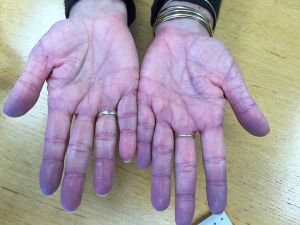Cyanosis
Introduction[edit | edit source]
Cyanosis is where your skin or lips turn blue.[1]
Presentation[edit | edit source]
Areas of the body most commonly affected
- lips
- tongue
- gums
- skin
- ends of fingers, toes and earlobes
for dark skin, cyanosis may be easier to see:
- on the lips, tongue and gums
- ends of fingers
- around the eyes[1]
Causes[edit | edit source]
Cyanosis can mean there's not enough oxygen in the blood, or poor blood circulation. The blue colouration is due to the unsaturated haemoglobin in the blood.
It can be caused by:
- asthma
- pneumonia
- choking
- croup
- heart failure
- congenital heart disease
Other causes of cyanosis include:
- Raynaud's Phenomenon, which affects your fingers and toes
- Ventricular failure
- beta blockers, a medicine used to treat high blood pressure
- a blood clot that stops the blood supply to or from a limb
- being in cold air or water
- wearing clothing or jewellery that's too tight[1]
Peripheral Cyanosis[edit | edit source]
Peripheral Cyanosis (fingers, toes and ears) occurs as a result of increased oxygen extraction by the peripheral tissue in the capillary bed. Low cardiac output, venous stasis (the pooling of blood in the veins), or exposure to extreme cold causing vasoconstrictions.[2]
Central Cyanosis[edit | edit source]
Central Cyanosis (mouth, lips and tongue) indicates a gaseous exchange problem, although it is an unreliable measure for hypoxaemia. [3] This could be caused by:
- Impaired gas exchange secondary to pneumonia
- Embolism and ventilation perfusion mismatch
- Impaired gas diffusion via the alveoli
- High altitude
- Anatomic shunts
- Right to left shunt in congenital heart disease
- Arteriovenous malformation
- Intrapulmonary shunt
- COPD - in both chronic bronchitis and emphysema
- End stages of Cystic Fibrosis
- ARDs (Acute Respiratory Distress Syndrome) due to impaired gaseous exchange. [4]
Treatments[edit | edit source]
- Treat the under lying condition
- Oxygen therapy[2]
References[edit | edit source]
- ↑ 1.0 1.1 1.2 NHS. Cyanosis. Available at https://www.nhs.uk/conditions/blue-skin-or-lips-cyanosis/ Accessed 30 November 2020
- ↑ 2.0 2.1 Adeyinka A, Kondamudi NP. Cyanosis. [Updated 2020 Sep 22]. In: StatPearls [Internet]. Treasure Island (FL): StatPearls Publishing; 2020 Jan-. Available from: https://www.ncbi.nlm.nih.gov/books/NBK482247/ (Accessed 30 November 2020)
- ↑ Hough A. Physiotherapy in Respiratory Care: An Evidence-based Approach to Respiratory and Cardiac Management. Third edition. 2001. Nelson Thomas Ltd.
- ↑ Porter S. Tidy's Physiotherapy. Fifteenth Edition. Elsevier. 2013







